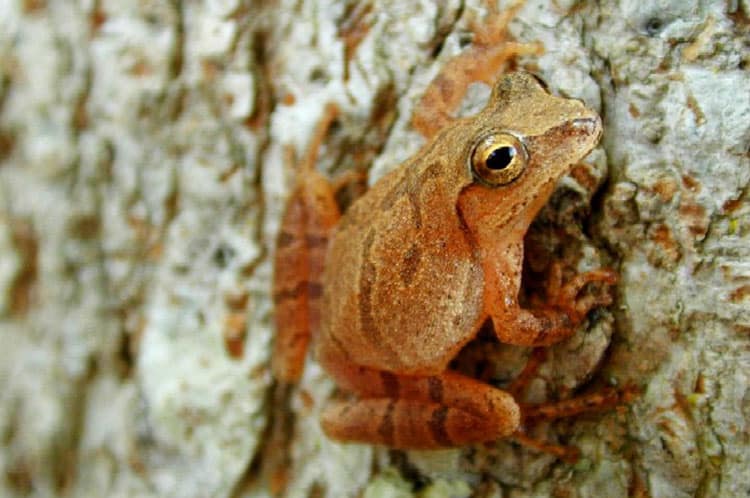• by Dr. Sarah Oktay, Director, University of Massachusetts Nantucket Field Station •
As August winds down and the feeling that summer is slipping away creeps up on us, I try to enjoy as many quintessential elements of Nantucket as I can. Last night, while walking our dog at the Nantucket Field Station on Polpis Road I noticed that the evening was filled with the sounds of frogs, grasshoppers, crickets, and a cicada or two instead of cars and voices from far off parties. In fact, the natural sounds became pretty loud and it inspired me to write the week’s column.
The loudest and most prevalent sounds are the trills and booms and clicks and peeps coming from our island frogs. There are just a few species of frogs found on Nantucket and the number of other amphibians is also much lower than the mainland, with many species being found all over Massachusetts except for Nantucket or Martha’s Vineyard (http://en.wikipedia.org/wiki/List_of_amphibians_of_Massachusetts) . One of the reasons why frogs are limited here is that we have less woodland habitats. They probably were here when we were connected to the Cape and then they were slowly extirpated. In some cases in the Northeast, when the Fowlers toad became locally instinct due to pesticide spraying, the American Toad was stocked to replace it (http://fl.biology.usgs.gov/Region_5_Report/html/toads_and_frogs.html) . The Massachusetts State reptile and amphibian list includes the following frog and toad species for Nantucket in addition to our very popular spring peeper (Pseudacris crucifer). In the True Frog family Ranidae we find the American Bullfrog (Lithobates catesbeianus), Green Frogs (Lithobates clamitans), and Pickerel Frogs (Lithobates palustris). The American Bullfrog is a relatively recent introductee to the island according to Massachusetts Fish and Wildlife site. The bullfrog sounds like the frog sound we would think of in a cartoon, very booming and “ribbety” http://www.youtube.com/watch?v=M02_dnl9zCA . The American bullfrog’s deep-pitched jug o’rum call can be heard for more than a quarter mile on quiet mornings.
One of my students found what I think may be a Northern Leopard frog this spring and we may have found another one last week during a “moth party” (an event in which we put out ultraviolet and mercury vapor lights to attract moths to identify them). They sound a bit jarring, check them out at http://www.youtube.com/watch?v=kUdeEw2BPsQ. I’ll be listening for them specifically over the next few weeks to see if they were actually just weird looking pickerel frogs. Spring peepers as the name makes clear are heard more in the spring and the early summer. I wrote about them five years ago (http://yesterdaysisland.com/archives/science/1-a.php ) for this column and you can listen to their call and learn more about them here: http://www.youtube.com/watch?v=zBUXYrUA2pw. The Nantucket Conservation Foundation’s Squam Swamp trail is an especially lovely place to go listen for frogs.
This link (http://www.youtube.com/watch?v=G0uGjsM_gh4) contains a short sound file for a green frog croaking. The green frog sounds like a guitar spring breaking and as soon as you hear it, you’ll be able to identify one. From the Animal Diversity website I found a series of sound files for various frogs. Just as I wish to know what is calling bird wise as I walk the island, I also like to know what I am listening to each night as the summer cools and fall beckons. The sound link for the pickerel frog, which is one of our most common frogs here on Nantucket, clearly illustrates the long rasping note that pickerel frogs make. The second sound file sounds a bit more like someone scratching an old vinyl record. UMass Amherst has a new website that lists the “calling amphibians of Massachusetts” (http://www.massnaamp.org/calling_amphibians.html).
This link (http://www.youtube.com/watch?v=yzuzxOQtd0Q ) runs through a variety of frog and toad calls and the first one we hear is the American Toad (Bufo Americanus), one of the only toad species on Nantucket. The sound they make is pretty, a long trill held at a slightly higher range. I recommend listening to the whole file just so you’ll know what you may be hearing in case you live elsewhere during the year. Once again, the green frog “broken guitar string” plunk is very distinctive.
Most frog and toad species have a wide range of calls that they use for different reasons. Advertisement calls are the loud calls that male frogs make to attract females. These are the calls that people are most familiar with because frogs are all about the ladies (or other species of frogs, or other males or trees if you watch enough videos of them). Some frog species have aggressive calls made by males towards other males, some have distress calls when bitten by a predator, and some have release calls when one male needs to tell another male to let go (honestly, frogs may have something on rabbits).
Two years ago I wrote about island cicadas (http://yesterdaysisland.com/natures-thermometers-cicadas/). Most of the time on Nantucket in the summer you are hearing a chorus of grasshoppers crickets and katydids with a few locusts thrown in for good measure. Grasshoppers, crickets, and locusts are all members of the Orthoptera order. These are relatively large insects which are adapted to jumping very high above the ground. Although they are very similar to one another, these three species of insects are divided into two other sub-orders. Grasshoppers and locusts belong to the Caelifera order, while crickets are members of the Enisfera suborder. These jumping insects can be found hiding in the grass during the day. They are herbivorous and feed on juicy plants and leaves.
From “the Difference between Grasshoppers and Crickets”: http://insects.answers.com/grasshoppers/the-difference-between-grasshoppers-and-crickets we learn that: “the most important clue to differentiate the two is that grasshoppers are active during the day, when you can hear them singing and see them jumping in the grass. Crickets hide in the ground during the day and come out at dusk, as they are nocturnal insects. You can be sure that it is a cricket singing under your window at night. Unlike the grasshopper, the cricket prefers to jump instead of flying. While both species can sing, the difference lies in how they produce the sounds. Crickets rub their forewings together, while grasshoppers rub their hind leg to their forewings. House crickets are omnivorous and are actually beneficial inside your pantry because they eat other harmful insects and clean any crumbs.”
Going back to Charles Willison Johnson’s famous 1930 book “A List of the Insect Fauna of Nantucket, Massachusetts” is a good way to pin down (a bad insect pun) what you might be hearing. (http://ag.udel.edu/research/delphacid/documents/Johnson1930aHomopteraonly.pdf). Johnson found 39 crickets, grasshopper and locust (Orthoptera) species including these that he singled out: Carinate Florida Katydid (sound file is here: http://entnemdept.ifas.ufl.edu/walker/buzz/265a.htm) pygmy mole cricket, spotted cave cricket, mole cricket, and the wingless prairie grasshopper (also known as a lubber). He did not find any cicadas but we know now that we have the “dog day” cicada (Tibicen lyricen). I wrote about that late summer loud mouth back in 2012 (http://yesterdaysisland.com/natures-thermometers-cicadas/). This website (http://www.insectsingers.com/100th_meridian_cicadas/) contains an extremely thorough collection of cicada songs.
Did you know you can approximately tell the temperature if you hear a cricket sing?? I remember this bit of folklore going back (way back) to my childhood and I was happy to ready find out that it is true. Crickets are pretty accurate thermometers; you can count the number of chirps in 15 seconds and then add 37 to arrive at an approximate temperature.
I hope you will take some time to walk around at dusk and in the late evening and listen for the many distinctive calls that frame the summer evenings. Take along your cell phone and use the record feature to save a sound file for those quiet winter nights. Try an experiment to see how close you can get to each calling creature, how many different calls you hear, and if you are feeling especially “scientific-ish” record the temperature to see how it correlates to the frogs, toads, crickets, locusts, grasshoppers, and other members of the band.



